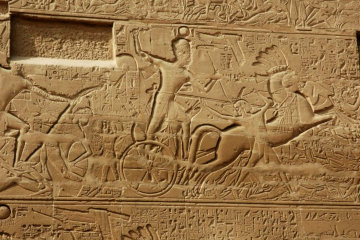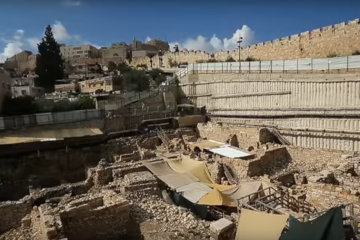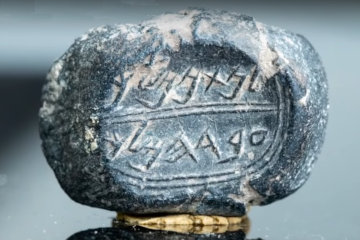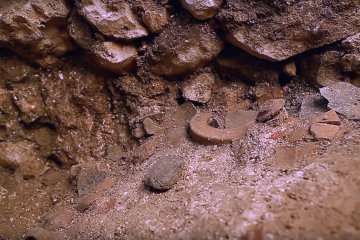The Eunuch's Bulla
When I was a boy - around about the time dinosaurs were deciding whether or not to enter Noah's ark - my Sabbath School ran on a three-year cycle of Bible stories in which suitably bowdlerised tales of errant kings and faithful prophets led you from Genesis to Revelation. Since then the churchly powers-that-be have changed things and now the Sabbath School classes focus on twee little stories of how men and women are equal and bullying is wrong and it's ok to cry. (Somehow I learned all those things and still came up with a good grasp of the kings of Israel whereas today's unfortunate youngsters look blank if you ask them who Josiah was.)
Mind you, there are many adults these days who would look similarly blank if asked the same question. As one newspaper report stated, "The only evidence for King Josiah as a historical rather than mythological figure comes from the Bible, with little supporting archaeological evidence."
Which is a pity, on two grounds.

| |
| A relief of Seti I in battle from the Karnak temple. I'm not sure whether this is the one referred to in the article. |
The first is that there is surprisingly little archaeological evidence for an awful lot of what passes as history. Read any detailed history of Egypt and it will tell you about the conquest of Palestine by Seti I. It may even, if it is detailed enough, tell you that the information is based on the important Karnak reliefs, so I thought you might be interested in knowing what those reliefs say.
There is a large and entirely conventional picture of Seti I in his chariot, bow pulled to its maximum extent, his horses' hooves poised over a square shape that is intended to represent a fortress and, of course, over the heaped up bodies of those slain by the royal prowess. Various elements of the picture bear hieroglyphic labels.
Over the king
King of Upper and Lower Egypt Menmare son of Re Seti-Mernetah given life like Re beloved of Menhyt.Over the fortress
Town of Pekanan.Over the horses
Great first span of his majesty called Victory-in-Thebes.Over the enemy
Year 1 King of Upper and Lower Egypt Menmare the destruction which the mighty sword of pharaoh life prosperity health made among the vanquished of the Shasu from the fortress of Tharu to Pekanan when his majesty marched against them like a fierce-eyed lion making them carcasses in their valleys overturned in their blood like those that exist not. Everyone that escapes his fingers says his might toward distant countries is the might of his father Amon who has assigned to him victorious valour in the countries.
James Henry Breasted, Ancient Records of Egypt vol. 3 p. 47
Unfortunately we do not know where this "Pekanan" was and the whole text is larded with references to Egyptian gods, yet no one dismisses this record as "mythological" or "untrustworthy" because it is "religious". It's hard not to be cynical when comparing the way in which Bible history is dismissed and Egyptian history believed implicitly!
Other inscriptions translated in Breasted's four volumes are equally wooly yet lead to equally profound conclusions about Egyptian history. Of course, I do not decry the endeavour to work with the little we have to extract every last nuance from it. I applaud the Egyptologists who analyse in profound detail the dress, weapons, order of appearance and anything else that might give us information about the past. I just wish they would apply the same openness and care in dealing with the Biblical record.
And, incidentally, I am not aware of any archaeological evidence to support the boasting by Seti I. We are hardly in a position to confirm that he conquered Pekanan when we don't even know where it is! We haven't found Seti's arrow-heads or the prints of his horses' hooves in Tharu nor even a stele in southern Palestine saying "Seti woz 'ere", yet Seti's campaign in Palestine is in all the history books based solely on his self-aggrandising claims - and pharaohs were not always entirely truthful on their boastings.
The second ground for regretting the dismissive comment in the newspaper is that while there may be "little archaeological evidence", that is by no means the same as "no archaeological evidence".

| |
| This excavation site just south of the Dung Gate used to be a public car park. |
Just south of the Old City of Jerusalem there is that rarest of all things in Jerusalem - a patch of empty ground. For many years it was used as a car park for the convenience of those wanting a short route from their car to the Western Wall, but a decade or so ago, following the dramatic discoveries near the Jebusite tunnel, the Israeli Antiquities Authority decided that it might be worthwhile to dig up the car park and see what they could find.
The first half a dozen feet were Muslim and Christian remains which were discarded without a whisper, but then the archaeologists struck gold - or its Palestinian equivalent. They started to dig up pottery that could be dated to the Second Temple period and beneath that was the destruction layer of the Babylonian conquest in 586 BC. I imagine that Finkelstein was not best pleased when the buildings uncovered proved to be large and well-built, not the insignificant cluster of huts that he had claimed was all that Biblical Jerusalem was.
In early 2019 Proffessor Yuval Gadot of Tel Aviv University and Dr Yiftah Shalev of the IAA announced a startling discovery made in one very large building that had been made of finely cut ashlars. The polished plaster floor - much damaged by the collapse of the building's second story - showed that this was an important public building. Charred beams and broken pots showed that the building met its end by fire and the lack of any attempt at rebuilding made it clear that this was no domestic fire but the result of enemy action.

| |
| The Nathan-melek bulla on display in the Israel Museum. |
In the ash - and darkened by it - was a small lump of clay, which made the archaeologist's heart leap with excitement, for such lumps were commonly used to seal something. It might be stuck at the bottom of a papyrus document or moulded around the knot in the string holding the lid on a storage jar, but wherever it was placed it was made official by having someone's seal impressed into the clay.
Usually the resulting impression is not all that exciting. Up in Samaria dozens of these "bullae" were found bearing nothing more than the single word "lmlk" (l'melek) meaning "for the king" or "belonging to the king". Woe betide the wine cellar guard who was found with a jar of wine sealed with a "l'mlk" seal!
Occasionally, however, the archaeologist really does strike gold and the seal gives the name of its owner and - if you are really really lucky - his position or his ancestry. The holy grail of bullae must surely be one bearing the name of King Solomon or, even better, his father King David, but in the meanwhile we have to be grateful for lesser mercies.
Before describing this discovery, however, we need to back up a bit and talk about King Josiah. The reign of King Manasseh was a disaster for Judah, both politically and religiously. Manasseh was forced to submit to the Assyrians - one record says that he was actually carried off to Nineveh for a short time - and the prophets gleefully declared that this was because his natural inclination was to abandon the staid worship of Yahweh in favour of the sexually charged worship of his neighbours gods. When the prophet Isaiah objected, Manasseh - according to legend - had him forced into a hollow log and the log sawn in half.
When Manasseh's son, Amon, seemed to be heading in the same direction as his father he provoked a palace conspiracy against himself and he was assassinated in one of the rooms of the palace in Jerusalem. I've no idea what the conspirators' long-term plans were, because the apalled common people rioted in protest and killed the assassins. They then put Amon's son - Manasseh's grandson - on the throne.
Josiah was only eight years old when this happened but those who ran the kingdom on his behalf did so wisely and well - and brought him up in the same way. Whether we can give any credit to his mother, a certain Jedidah from Boscath, I don't know but I think it likely.
2 Kings 22:3 says that "in the eighteenth year of King Josiah", without clarifying whether that was the eighteenth year of his life or his reign. I like to think it was the former, for his radical actions are typical of teenage briskness. He abruptly commanded that the derelict temple be repaired using the money collected by the doorkeepers from pilgrims to the temple. What the doorkeepers thought of this sudden seizure of what they must have regarded as a most useful perk, is not recorded, but I get the impression that Josiah wasn't greatly bothered.
In the course of the repairs someone came across a long-forgotten chest containing a scroll of papyrus which, on investigation, turned out to be a copy of the laws given by God to Moses. When read to the king (who was probably illiterate) the contents of the scroll galvanised him into action.
First of all he organised a public gathering at which the book (or a precis) was read and then the king led the people in dedicating themselves to obeying the law of God. Then he sent out trusted men to purify the temple and the city of any hint of idolatry. The cult priests in all the high places throughout Judah were suppressed, the sacred brothels (both male and female) were closed, the places of sacrifice were defiled and the sun-horses - well, the sun had to have someone to draw his chariot across the sky each day! - were chased out of their stable and set to work for the first time in their pampered lives.
It is a measure of how far the Jews had strayed from the worship of Yahweh that this stable was located right outside the temple gateway, next door to the office of Nathan-melek, the royal chamberlain. (2 Kings 23:11) And Nathan-melek is the name stamped on the recently discovered bulla, whose inscription reads "l'nathan-melek ebed hamelek". "Melek", of course, is "king" and "ebed" is "servant", so the seal states "belonging to Nathan-melek, servant of the king".
Either Nathan's mother had high hopes for her baby boy, or he changed his name to suit new circumstances in his life - a by no means unknown action in the east - for "Nathan-melek" means "the king gives". I suppose the mother might have been a royal concubine or mistress, or she may have just been an ambitious mother hoping that her son would receive recognition by the king.
"Ebed", although the word simply means "slave" or "servant", was also a job title or description and it is possible that Nathan-melek preferred it to the title given him by the Bible, which refers to him as "Nathan-melek the eunuch". However accurate the term may have been, one cannot blame Nathan-melek if he signed official documents with "servant of the king"!

| |
| Debris on the floor of the chamber where the Nathan-melek bulla was found. |
Of course bits of papyrus, even ones that bear the stamps of important royal officials, can end up anywhere the vagaries of filing systems and royal archives take them, but in the same spirit with which Breasted milked every possible nuance out of the Karnak reliefs, let's just toy for a moment with the thought that this bulla may have been found in the place from which it originated.
Some years ago Dr Asher Kaumann caused a stir by claiming that the Jewish temple was located some hundred yards north-west from the Dome of the Rock. For a time some even suggested that the Jewish temple might be rebuilt without in any way harming the Muslim sanctuary - and idea that failed to gain favour with either Jews or Muslims! Others have place the temple to the south of the Dome of the Rock with some even favouring a site down by the Spring Gihon!
However if this bulla was found in Nathan-melek's office and if we take literally that Biblical statement that his office was next to the temple gate, then that would place the temple somewhere under the road that presently runs past the Dung Gate and up to the Zion Gate. The thought that the temple of Solomon might be found - and if found, rebuilt - sufficiently far from the Haram esh-Sherif to avoid offending Muslim susceptibilities, is a delightful one.
It would, of course, instantly devalue all those high-priced appartments that overlook the Wailing Wall and destroy the business of that chap who prints out e-mailed or faxed prayers and wedges them into the cracks between the stones of that Wall, but sayings about eggs and omelettes spring to mind. Alas, I fear it is only a daydream and the Haram is, in all probability, the site of the temple.
Still, one thing is certain: if Josiah's "chamberlain" (eunuch) was a real person with a very solid seal and bullae, then we can be confident that Josiah also was a real person and who knows? Perhaps his seal will be the next to be found.
a copy of the laws Some have suggested that in fact this "discovery" was a pious forgery intended to reinforce the position of the Jerusalem hierarchy and is now known as the book of Deuteronomy (the Second Law). I applaud the ingenuity of the suggestion and of the arguments used to support it, but in the end I don't find them convincing. Return
© Kendall K. Down 2019





